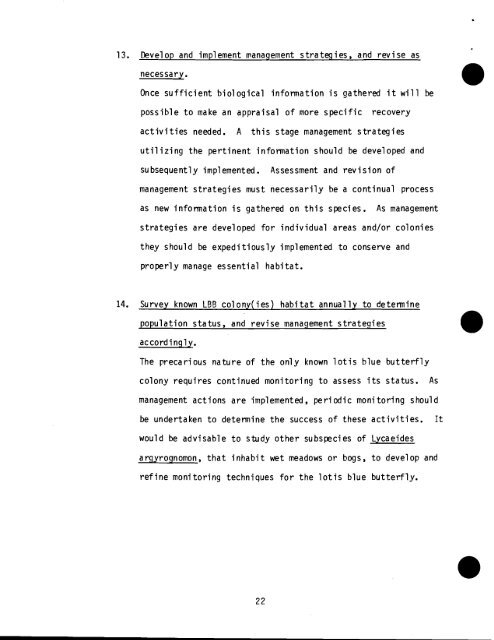Lotis Blue Butterfly Recovery Plan - U.S. Fish and Wildlife Service
Lotis Blue Butterfly Recovery Plan - U.S. Fish and Wildlife Service
Lotis Blue Butterfly Recovery Plan - U.S. Fish and Wildlife Service
You also want an ePaper? Increase the reach of your titles
YUMPU automatically turns print PDFs into web optimized ePapers that Google loves.
13. Devel op <strong>and</strong> impl ement management s tra teg i es , <strong>and</strong> rev i se as<br />
necessary.<br />
Once sufficient biological information is gathered it will be<br />
possible to make an appraisal of more specific recovery<br />
act iv i ties needed. A this stage management strategies<br />
util izi ng the pertinent information should be developed <strong>and</strong><br />
subsequently impl emented. Assessment <strong>and</strong> revision of<br />
management strategies must necessarily be a continual process<br />
as new information is gathered on this species. As management<br />
strategies are developed for individual areas <strong>and</strong>/or colonies<br />
they should be expeditiously implemented to conserve <strong>and</strong><br />
properly manage essential habitat.<br />
14. Survey known LBB colony(ies) habitat annually to determine<br />
population status, <strong>and</strong> revise management strategies<br />
accordingly.<br />
The precarious nature of the only known lotis blue butterfly<br />
colony requires continued monitoring to assess its status. As<br />
management actions are implemented, peri odic moni toring should<br />
be undertaken to determine the success of these activities. It<br />
would be advisable to study other subspecies of Lycaeides<br />
argyrognomon, that inhabit wet meadows or bogs, to develop <strong>and</strong><br />
refine monitoring techniques for the 1 ot is blue butterfly.

















